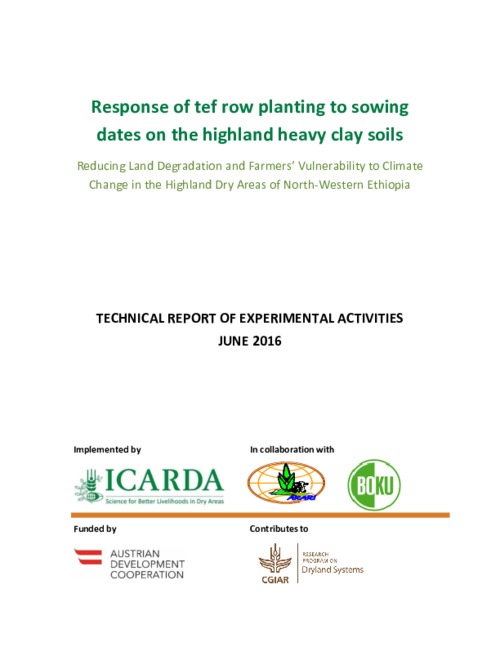Location
The International Center for Agricultural Research in the Dry Areas (ICARDA) was established in 1977. It is one of 15 such centers supported by the CGIAR. ICARDA’s founding mandate to promote agricultural development in the dry areas of developing countries remains highly relevant today.
ICARDA works with a tight focus on the problem-solving needs of resource-poor farmers, achieving this through the in-field delivery of its research outputs. Although global food production has increased by 20 per cent in the past decade, food insecurity and poverty remain widespread, while the natural resource base continues to decline.
International research centers such as ICARDA, which have helped drive previous improvements, continue to deliver new technologies to support sustainable growth in agriculture, and crucially, to work with a wide range of partners to accelerate the dissemination of these technologies.
ICARDA’s biggest strength is its staff – 600 highly skilled men and women from 32 countries. Our research and training activities cover crop improvement, water and land management, integrated crop-livestock-rangeland management, and climate change adaptation.
Other interventions include:
- Water harvesting - supplemental irrigation and water-saving irrigation techniques
- Conservation agriculture methods to reduce production costs and improve sustainability
- Diversification of production systems to high-value crops – horticulture, herbal and medicinal plants
- Integrated crop/rangeland/livestock production systems including non-traditional sources of livestock feed
- Empowerment of rural women – support and training for value-added products.
The ICARDA genebank holds over 135,000 accessions from over 110 countries: traditional varieties, improved germplasm, and a unique set of wild crop relatives. These include wheat, barley, oats and other cereals; food legumes such as faba bean, chickpea, lentil and field pea; forage crops, rangeland plants, and wild relatives of each of these species.
ICARDA’s research portfolio is part of a long-term strategic plan covering 2007 to 2016, focused on improving productivity, incomes and livelihoods among resource-poor households.
The strategy combines continuity with change – addressing current problems while expanding the focus to emerging challenges such as climate change and desertification.
We work closely with national agricultural research systems and government ministries. Over the years the Center has built a network of strong partnerships with national, regional and international institutions, universities, non-governmental organizations and ministries in the developing world and in industrialized countries with advanced research institutes.
THE ‘DRY AREAS’
Research and training activities cover the non-tropical dry areas globally, using West Asia, North Africa, Central Asia and the Caucasus as research platforms to develop, test, and scale-out new innovations and policy options.
Dry areas cover 41 per cent of the world’s land area and are home to one-third of the global population. About 16 per cent of this population lives in chronic poverty, particularly in marginal rainfed areas. The dry areas are challenged by rapid population growth, frequent droughts, high climatic variability, land degradation and desertification, and widespread poverty. The complex of relationships between these challenges has created a "Poverty Trap."
Members:
Resources
Displaying 176 - 180 of 431Response of tef row planting to sowing dates on the highland heavy clay soils: Reducing Land Degradation and Farmers’ Vulnerability to Climate Change in the Highland Dry Areas of North-Western Ethiopia
Teff, Eragrostis tef /zucc./ Trotter is one of the most important cereal crops in Ethiopia that occupies (32%), the largest cultivated area under cereals and 26% of the whole area cultivated to annual field crops by covering about two million hectares of land annually. Tef is adapted to environments ranging from drought stress to water logged soil conditions. It can be grown at altitude ranging from sea level to 3000m above sea level, with the maximum production occurs between 1700 and 2400m.
Kyrgyzstan Case Study Policy Brief
Policy recommendations on sustainable land management in Kyrgyzstan, including costs and benefits of alternative options. Conclusion: Summer pastures across the Kyrgyz Republic can provide greater economic and environmental benefits through improving pasture yields sustainably
Turkmenistan Case Study Policy Brief
Policy recommendations on sustainable land management in Turkmenistan, including the costs and beneifts of alternative options. Conclusiion: Rehabilitating pasturelands and undertaking sustainable land management in deserts across Turkmenistan brings both economic and environmental benefits
Broadening land management options for improved economic sustainability across Central Asia: A synthesis of national studies
Land degradation is a pressing concern that reaches
across all republics of Central Asia and is increasingly
affecting the economy and quality of life in each.
The resulting loss of arable land particularly affects
the rural poor, who depend directly on what
the land can provide for their very survival and
livelihoods. The breakup of the Soviet Union led to
mass de-collectivisation of agricultural frameworks
across Central Asia, with formerly centralised land
management regimes dissolved. The reorganisation
Uzbekistan Case Study Policy Brief
Policy recommendations on sustainable land management in Uzbekistan, including costs and benefits of alternative options. Conclusion: Diversifying agricultural production, retaining biomass in the field, and planting strips of forest can lead to economic and environmental benefits.







